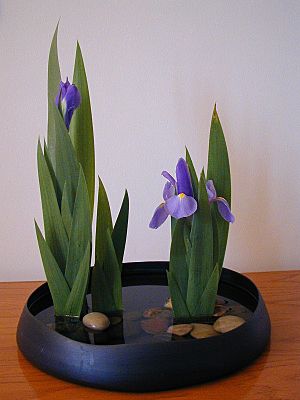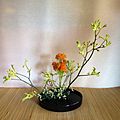Ikebana facts for kids
Ikebana (pronounced Ee-keh-bah-nah) is a special Japanese art. It's all about making beautiful flower arrangements. The word "Ikebana" in Japanese means "making flowers come alive." It's much more than just putting flowers in a vase. Each Ikebana arrangement has a deep meaning and tells a story. People who learn Ikebana spend a lot of time understanding how to create these special arrangements.
Contents
What are Ikebana Schools?
Just like there are different styles of painting or music, there are many different "schools" or styles of Ikebana. These schools teach the art in their own unique ways. Some of the most famous schools include Ikenobo, Sogetsu, and Ohara.
The Ikenobo School
The Ikenobo school is very old and well-known. It was started by a Buddhist priest named Ikenobo Senkei in the 15th century. For a long time, only people from the upper class could learn Ikenobo.
Ikenobo often uses a style called "rikka," which means "standing flowers." This style is a way to show the beauty of nature through flowers. A traditional rikka arrangement has seven main parts, and each part represents something from nature, like a hill, a valley, or a waterfall.
Later, around the 17th century, a simpler style called "shoka" became popular. Shoka arrangements are easier to make and use only three main branches. These three branches represent "ten" (heaven), "chi" (earth), and "jin" (man).
Other Ikebana Styles
Another style of Ikebana is called cha-bana. This style is often used during the Japanese tea ceremony. Ikebana is also a popular art form for decorating homes in Japan.
Ikebana Today
Today, Ikebana is very popular with all kinds of people in Japan, not just the upper class. Millions of people in Japan practice this beautiful art. It's a way for them to connect with nature and express their creativity.
Images for kids
-
Woodcut ukiyo-e print by Eishi of a lady practicing ikebana
-
Rikka arrangement by Ikenobō Senkō II, a drawing from the Rikka-no-Shidai Kyūjūsanpei-ari, Important Cultural Property
See also
 In Spanish: Ikebana para niños
In Spanish: Ikebana para niños
















